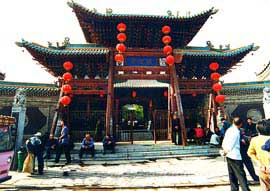| Legole.Com Discover china. Explore the beauty and wonder of the land, people, and culture of China. |
 |
| The Temple of the City God |
 Pingyao's Temple of the City God was built during the Northern Song Dynasty (960 - 1127) and is an essential venue for visitors who seek to appreciate and understand the cultural and religious background of this city. Pingyao's Temple of the City God was built during the Northern Song Dynasty (960 - 1127) and is an essential venue for visitors who seek to appreciate and understand the cultural and religious background of this city.
The temple has undergone two restorations, the first during the Ming (1368 - 1644) and the second in the Qing Dynasty (1644 - 1911), with the result that the overall area it covers today is 7302 square meters (8733 square yards). Situated on the main Nanda Jie, the temple stands symmetrically in an east-west direction from the county government office.
The Hall of the City God is the principal building and it stands in the centre of the complex. Four courtyards set on a north-south axis together with the buildings that compliment them have been maintained in good condition and each serve a specific purpose. The temple has a rich cultural heritage and it bears witness to the way in which aspects of Confucianism, Taoism and the ancient customs of the Han people of the middle and lower reaches of the Yellow River have been brought together in ritual, design and decoration. The architectural style is Taoist involving the use of blue and green tiles that confirm the high level of importance the temple had for the city. Elaborate wall paintings, lifelike clay sculptures, exquisitely carved bricks and wood carvings as well as the ingenious carpentry used in the construction of the buildings are monuments to the craftsmanship and skill of those responsible for their completion. The classical Qing Dynasty ornamentation of the roof ridges, with their myriads of floral and fauna, both real and mythical, is a feast for the eyes.
The visitor is welcomed to the temple by a double eaved, triple gated wooden archway that is supported on four great wooden pillars. An inscription above the central gate calls upon all to behave with integrity and honour and warns those who act in an unjust manner to expect punishment by the City God. A stone mounting block for the use of horsemen stands in front of the gate. On either side of the gateway there are intricately moulded brick screens and the area has become a popular meeting place for the people of the city. Here they like to sit and chat or play a game of cards.
The arch gives access to the first courtyard and the Mountain Gate, traditionally the prime entrance to a temple. Passing through the central doorway, the visitor will see portraits of two gods who are its guardians and who ward off evil spirits that may attempt to enter the holy place. The gate leads to the first main building, the Theatre Hall. This two storey hall is a focus for theatrical performances in Pingyao and it is here that people assemble during the annual Temple Fair to enjoy opera performances by various groups that are sponsored by commercial organisations or local citizens. The Fair takes place around the 27th May each year, when a swarm of vendors selling snacks mingle with the audience, adding to the excitement of the happy occasion. Five or six large urns were strategically placed within a centrally positioned hollow. These created an echo effect and the resonance they produced amplified the voices of the performers, an efficient but simple fore runner of the modern sound system!
To either side of the Theatre Hall there stands the Bell Tower and Drum Tower, each with their ornate tiled canopy. Archways through the towers give access to the second courtyard.
On the north side of the courtyard, upon a marble terrace, stands the Hall of Prayer. In this hall, worshippers come to burn incense and to offer up prayers to the god. The hall is richly decorated and sixteen wall paintings illustrate a series of both historical and mythical events. Crossing the Hall of Prayer, you will enter a spacious hall that is set out rather like a court of law. Upon an elevated alter there is a niche containing a brightly colored clay sculpture of the City God, with an attendant on either side. Adding to the awesome atmosphere there are rows of similarly sculpted colourful figures. These represent officials who attend the God and each one bears an individual animated facial expression.
The walls are decorated with fine realistic paintings in a true Chinese style. Measuring 8.05 meters in width and 4.5 meters in height, the pictures show the City God on a tour of inspection. Altogether there are forty eight figures, all with different vivid and lifelike facial expressions.
Behind the alter a door leads to the next courtyard and the sleeping quarters of the City God.
An attractive drooping flower door, with its horizontal plaque bearing gilded characters, opens onto the fourth courtyard. On the north side there is the two storied Sleep Hall. This peculiar structure combines lower cellars and upper rooms that are the sleeping quarters of the City God and the City Goddess.
As well as the principle buildings that have been described there are a number of auxiliary rooms leading off the various courtyards. The entire complex is a treasure trove of magnificent Chinese architecture and decorative art forms. This temple is a fine example of both deeply rooted religious and cultural traditions of our country. |
 |
|
|
 |
|
